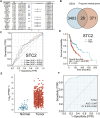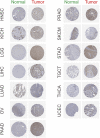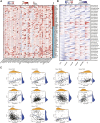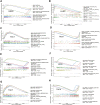A Pan-Cancer Analysis Reveals the Prognostic and Immunotherapeutic Value of Stanniocalcin-2 (STC2)
- PMID: 35937984
- PMCID: PMC9354991
- DOI: 10.3389/fgene.2022.927046
A Pan-Cancer Analysis Reveals the Prognostic and Immunotherapeutic Value of Stanniocalcin-2 (STC2)
Abstract
Background: Stanniocalcin-2 (STC2) is a secreted glycoprotein which plays an important role in regulating the homeostasis of calcium, glucose homeostasis, and phosphorus metastasis. Accumulating evidence suggests that STC2 is implicated in cancer mechanisms. However, the effects of STC2 on cancer development and progression across pan-cancer are not yet completely known. Methods: Data were downloaded from The Cancer Genome Atlas database to obtain differentially expressed genes significantly associated with prognosis (key genes). A gene was selected for subsequent correlation studies by integrating the significance of prognosis and the time-dependent ROC curve. Gene expression of different tumor types was analyzed based on the UCSC XENA website. Furthermore, our study investigated the correlation of STC2 expression between prognosis, immune cell infiltration, immune checkpoint genes (ICGs), mismatch repair genes (MMRs), tumor mutation burden (TMB), microsatellite instability (MSI), and drug sensitivity in various malignant tumors. Gene set enrichment analysis (GSEA) was conducted for correlated genes of STC2 to explore potential mechanisms. Results: A total of 3,429 differentially expressed genes and 397 prognosis-related genes were identified from the TCGA database. Twenty-six key genes were found by crossing the former and the latter, and the highest risk gene, STC2, was selected for subsequent correlation studies. STC2 had good diagnostic performance for HNSCC, and was closely related to the survival status and clinicopathological stage of HNSCC patients. In pan-cancer analysis, STC2 was upregulated in 20 cancers and downregulated in seven cancers. STC2 overexpression was overall negatively correlated with overall survival, disease-free survival, disease-specific survival, and progress-free survival. STC2 was profoundly correlated with the tumor immune microenvironment, including immune cell infiltration, ICGs, MMRs, TMB, and MSI. Moreover, STC2 was significantly negatively correlated with the sensitivity or resistance of multiple drugs. Conclusion: STC2 was a potential prognostic biomarker for pan-cancer and a new immunotherapy target.
Keywords: head and neck squamous cell carcinoma; pan-cancer; prognostic biomarkers; stanniocalcin-2; target therapy.
Copyright © 2022 Jiang, Shen, Wei, Chen, Chai, Xia and Leng.
Conflict of interest statement
The authors declare that the research was conducted in the absence of any commercial or financial relationships that could be construed as a potential conflict of interest.
Figures










Similar articles
-
Identification of SHCBP1 as a potential biomarker involving diagnosis, prognosis, and tumor immune microenvironment across multiple cancers.Comput Struct Biotechnol J. 2022 Jun 18;20:3106-3119. doi: 10.1016/j.csbj.2022.06.039. eCollection 2022. Comput Struct Biotechnol J. 2022. PMID: 35782736 Free PMC article.
-
Transcriptome and pan-cancer system analysis identify PM2.5-induced stanniocalcin 2 as a potential prognostic and immunological biomarker for cancers.Front Genet. 2023 Jan 6;13:1077615. doi: 10.3389/fgene.2022.1077615. eCollection 2022. Front Genet. 2023. PMID: 36685853 Free PMC article.
-
Pan-Cancer Analysis of PDIA3: Identifying It as a Potential Biomarker for Tumor Prognosis and Immunotherapy.Oxid Med Cell Longev. 2022 Aug 22;2022:9614819. doi: 10.1155/2022/9614819. eCollection 2022. Oxid Med Cell Longev. 2022. PMID: 36046686 Free PMC article.
-
Stanniocalcin 2 (STC2): a universal tumour biomarker and a potential therapeutical target.J Exp Clin Cancer Res. 2022 May 2;41(1):161. doi: 10.1186/s13046-022-02370-w. J Exp Clin Cancer Res. 2022. PMID: 35501821 Free PMC article. Review.
-
The significance of Stanniocalcin 2 in malignancies and mechanisms.Bioengineered. 2021 Dec;12(1):7276-7285. doi: 10.1080/21655979.2021.1977551. Bioengineered. 2021. PMID: 34612765 Free PMC article. Review.
Cited by
-
Development and experimental validation of hypoxia-related gene signatures for osteosarcoma diagnosis and prognosis based on WGCNA and machine learning.Sci Rep. 2024 Aug 12;14(1):18734. doi: 10.1038/s41598-024-69638-3. Sci Rep. 2024. PMID: 39134603 Free PMC article.
-
CH25H Promotes Autophagy and Regulates the Malignant Progression of Laryngeal Squamous Cell Carcinoma Through the PI3K-AKT Pathway.Cancer Med. 2024 Oct;13(20):e70312. doi: 10.1002/cam4.70312. Cancer Med. 2024. PMID: 39428922 Free PMC article.
-
Predictive and Prognostic Relevance of Tumor-Infiltrating Immune Cells: Tailoring Personalized Treatments against Different Cancer Types.Cancers (Basel). 2024 Apr 23;16(9):1626. doi: 10.3390/cancers16091626. Cancers (Basel). 2024. PMID: 38730579 Free PMC article. Review.
-
UBE2C: A pan-cancer diagnostic and prognostic biomarker revealed through bioinformatics analysis.Cancer Rep (Hoboken). 2024 Apr;7(4):e2032. doi: 10.1002/cnr2.2032. Cancer Rep (Hoboken). 2024. PMID: 38577722 Free PMC article.
-
Decoding breast cancer heterogeneity: a novel three-gene signature links intratumoral heterogeneity with tumor microenvironment and patient outcomes.Discov Oncol. 2025 Jul 1;16(1):1218. doi: 10.1007/s12672-025-03039-4. Discov Oncol. 2025. PMID: 40591124 Free PMC article.
References
-
- Brown N. F., Williams M., Arkenau H.-T., Fleming R. A., Tolson J., Yan L., et al. (2018). A Study of the Focal Adhesion Kinase Inhibitor GSK2256098 in Patients with Recurrent Glioblastoma with Evaluation of Tumor Penetration of [11C]GSK2256098. Neuro Oncol. 20 (12), 1634–1642. 10.1093/neuonc/noy078 - DOI - PMC - PubMed
-
- Chen W. N., Zhu G. J. (2008). Progress in the Research of Stanniocalcin. Sheng Li Ke Xue Jin Zhan 39 (3), 225–228. - PubMed
Publication types
LinkOut - more resources
Full Text Sources

